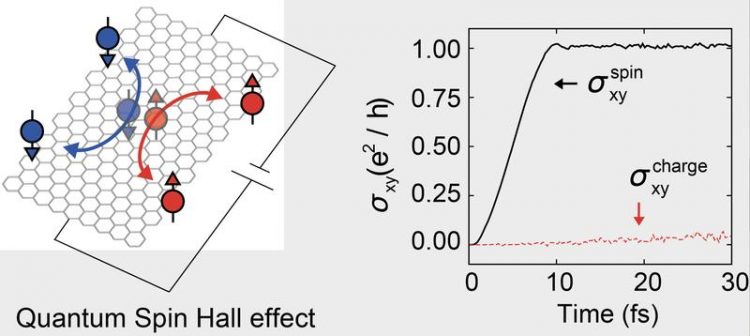Unraveling materials' Berry curvature and Chern numbers from real-time evolution of Bloch states

The exact opposite transversal flow of spin-up and spin-down electrons, leading to zero charge Hall conductivity but with a finite quantized spin Hall conductivity. Dongbin Shin
Einstein is commonly quoted as saying: “The most incomprehensible thing about the world is that it is comprehensible. The fact that it is comprehensible is a miracle.”
This statement is derived from an article he wrote in 1936 for the Journal of the Franklin Institute. From a physicist’s perspective, such a ‘miraculous comprehension’ most likely indicates that the observed phenomena are very well interpreted by the natural laws, expressed as mathematical equations.
On the other hand, the objectivity and indispensability of mathematical knowledge have been debated ever since Plato and Aristotle. Similarly, questions regarding the role of mathematics in the study of physical phenomena have been raised in recent solid state physics, particularly on the topological notion of insulators.
Thouless et. al. proposed in 1982¹ that the Hall conductivity of an insulator is to be quantized as indexed by a mathematically-devised integer, reflecting the topological structure of the quantum mechanical nature.
Since then, Michael Berry (1984)² has identified that such a mathematical number should be related to the phase structure of the quantum mechanical wave-function. According to Haldane (1988)³ and Kane and Mele (2005)⁴, real materials can be geared by spin-orbit coupling to possess such a non-trivial topological number. This has resulted in a wealth of studies to explore topologically non-trivial materials, particularly for the systems preserving time-reversal symmetry.
In this very mathematical characterization of physical systems, a great doubt is cast over the realness of the mathematically devised number or whether the topological constant can be measured experimentally. Instead of directly contemplating on this issue, the team has developed a computation method that can accurately calculate the Hall conductivity of insulators.
The scientists found that the entire classification of these materials can be achieved by their conductivity itself instead of the mathematically devised topological number. By calculating the time-dependent quantum mechanical equation, they were able to numerically quantify the electrons’ velocity, which was formulated by Michael Berry (1984). The summation of the electrons’ velocity is to be quantized and the detailed intrinsic quantum mechanical structure can be labelled by those quantum numbers.
In short, the team proposes to use physical quantity, less contaminated by mathematical notion, to characterize the materials’ properties, which provide a more direct link to experimental measurements.
REFERENCES
1 D. J. Thouless, M. Kohmoto, M. P. Nightingale, and M. den Nijs, Quantized Hall Conductance in a Two-Dimensional Periodic Potential, Physics Review Letters 49, 405 (1982)
2 M. V. Berry, Quantal Phase-Factors Accompanying Adiabatic Changes, Proc. R. Soc. Lon. Ser-A 392, 45 (1984).
3 F. D. M. Haldane, Model for a Quantum Hall-Effect without Landau-Levels-Condensed-Matter Realization of the Parity Anomaly, Physical Review Letters 61, 2015 (1988)
4 C. L. Kane and E. J. Mele, Quantum spin Hall effect in graphene, Physical Review Letters 95, 22 (2005)
Noejung Park (corresponding author): noejung@unist.ac.kr
Jenny Witt, PR officer, MPSD: jenny.witt@mpsd.mpg.de / +49 (0)40 8998 6593
Media Contact
More Information:
http://www.mpsd.mpg.deAll latest news from the category: Physics and Astronomy
This area deals with the fundamental laws and building blocks of nature and how they interact, the properties and the behavior of matter, and research into space and time and their structures.
innovations-report provides in-depth reports and articles on subjects such as astrophysics, laser technologies, nuclear, quantum, particle and solid-state physics, nanotechnologies, planetary research and findings (Mars, Venus) and developments related to the Hubble Telescope.
Newest articles

First-of-its-kind study uses remote sensing to monitor plastic debris in rivers and lakes
Remote sensing creates a cost-effective solution to monitoring plastic pollution. A first-of-its-kind study from researchers at the University of Minnesota Twin Cities shows how remote sensing can help monitor and…

Laser-based artificial neuron mimics nerve cell functions at lightning speed
With a processing speed a billion times faster than nature, chip-based laser neuron could help advance AI tasks such as pattern recognition and sequence prediction. Researchers have developed a laser-based…

Optimising the processing of plastic waste
Just one look in the yellow bin reveals a colourful jumble of different types of plastic. However, the purer and more uniform plastic waste is, the easier it is to…


